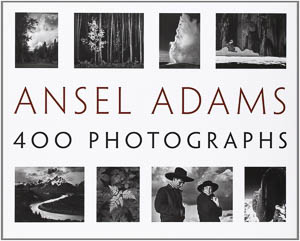Ansel Adams

400 photographs
Ansel Adams. 400 photographs, Andrea G. Stillman, Little, Brown and Company, 2007 Ansel Easton Adams (1902 - 1984)Seules les images fortement saisies ont la faculté de pénétrer pronfondément dans la mémoire, d'y rester, de devenir, en somme inoubliables. C'est pour moi le seul critère d'une bonne photographie.
Vous ne prenez pas une photographie, vous la faite.
à propos d'Ansel Adams
1902 - 1984
Sa démarche s'inscrit dans la « straight photography » (photographie pure) initiée par Alfred Stieglitz et Paul Strand.
En 1932, il fonde avec Edward Weston le Groupe f/64 en 1932 (la plus petite ouverture d'un objectif de chambre photographique) qui se donne comme but de reproduire la réalité le plus précisément possible.
En 1939, il développe avec Fred Archer la théorie du « zone system » un système de de prévisualisation du rendu de la scène photographiée.
Ansel Adams nous montre la beauté de la nature sauvage telle qu'elle se présente dans des parcs nationaux américains et tout particulièrement celui de Yosemite park.
J’espère que mon travail encouragera d’autres à s’exprimer, et à stimuler la recherche de la beauté et de l’excitation créative dans le grand monde autour de nous.
I hope that my work will encourage self expression in others and stimulate the search for beauty and creative excitement in the great world around us.
Ses images sont des icônes : The moonrise, Moon and Half Dome (1960), Acoma Pueblo, Church, Taos Pueblo (New Mexico, 1942)...
Pour ma part, c'est aux Rencontres d’Arles en 2006 que j'ai vu pour la première fois quelques uns de ses tirages originaux.
En parcourant les parcs naturels américains, beaucoup de ces images me sont revenues. En fait, souvent les lieux n’avaient finalement pas beaucoup changé sauf peut être à Hernandez, New Mexico où le 31 oct. 1941, Andsel Adams y prenait sa fameuse photographie The moonrise.
I had been photographing in the Chama Valley , north of Santa Fe. I made a few passable negatives that day and had several exasperating trials with subjects that would not bend to visualization. The most discouraging effort was a rather handsome cottonwood stump near the Chama River. I saw my desired image quite clearly, but due to unmanageable intrusions and mergers of forms in the subject my efforts finally foundered, and I decided it was time to return to Santa Fe. It is hard to accept defeat, especially when a possible fine image is concerned. But defeat comes occasionally to all photographers, as to all politicians, and there is no use moaning about it.
We were sailing southward along the highway not far from Espanola when I glanced to the left and saw an extraordinary situation – an inevitable photograph! I almost ditched the car and russed to set up my 8×10 camera. I was yelling to my companions to bring me things from the car as I struggled to change components on my Cooke Triple-Convertible lens. I had a clear visualization of the image I wanted, but when the Wratten No. 15 (G) filter and the film holder were in place, I could not find my Weston exposure meter! The situation was desperate: the low sun was trailing the edge of the clouds in the west, and shadow would soon dim the white crosses.
I was at a loss with the subject luminance values, and I confess I was thinking about bracketing several exposures, when I suddenly realized that I knew the luminance of the moon – 250 c/ft2. Using the Exposure Formula, I placed this luminance on Zone VII; 60 c/ft2 therefore fell on Zone V, and the exposure with the filter factor o 3x was about 1 second at f/32 with ASA 64 film. I had no idea what the value of the foreground was, but I hoped it barely fell within the exposure scale. Not wanting to take chances, I indicated a water-bath development for the negative.
Realizing as I released the shutter that I had an unusual photograph which deserved a duplicate negative, I swiftly reversed the film holder, but as I pulled the darkslide the sunlight passed from the white crosses; I was a few seconds too late!
Aujourd’hui la petite église existe toujours mais elle est à peine visible de la route. Je suis passé deux fois devant sans la voir...